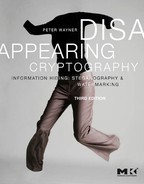Table of Contents
Chapter 1. Framing Information
2.2. Encryption and White Noise
2.3. Measuring and Encrypting Information
3.3. Constructing Error-Correcting Codes
4.1. Two out of Three Musketeers
4.3. Building Secret-Sharing Schemes
4.4. Public-Key Secret Sharing
5.3. Building Compression Algorithms
6.1. Reading between the Lines
Chapter 7. Grammars and Mimicry
7.1. Evolution of Everyday Things
7.2. Using Grammar for Mimicry
7.3. Creating Grammar-Based Mimicry
7.3.2. Suggestions for Building Grammars
8.1. Doggie's Little Get Along
8.3. Building a Reversible Machine
8.3.1. Reversible Turing Machines
Chapter 10. Anonymous Remailers
10.7.1. Establishing a Circuit
10.8. Anonymous Auction Protocols
12.4.1. Leveraging Public-Key Cryptography
12.4.2. Constraining Hard Problems
12.5. Zero Knowledge Approaches
Chapter 13. Ordering and Reordering
13.1. Top 10 Reasons Why Top 10 Lists Fail
13.3. Strength Against Scrambling
13.6. Packing in Multiple Messages
13.7. Sorting to Hide Information
13.11. Continuous Use and Jamming
14.2. Spreading the Information
14.6. The Fast Fourier Transform
14.7. Hiding Information with FFTs and DCTs
14.7.1. Tweaking a Number of Coefficients
15.3. Text Position Encoding and OCR
16.1. A Patent for Watermarking Humans
16.2. Tagging Digital Documents
17.4. Visual and Aural Attacks
19.1. Stealing Baseball's Signs
Chapter 20. Translucent Databases
20.3. Using Strong One-Way Functions
